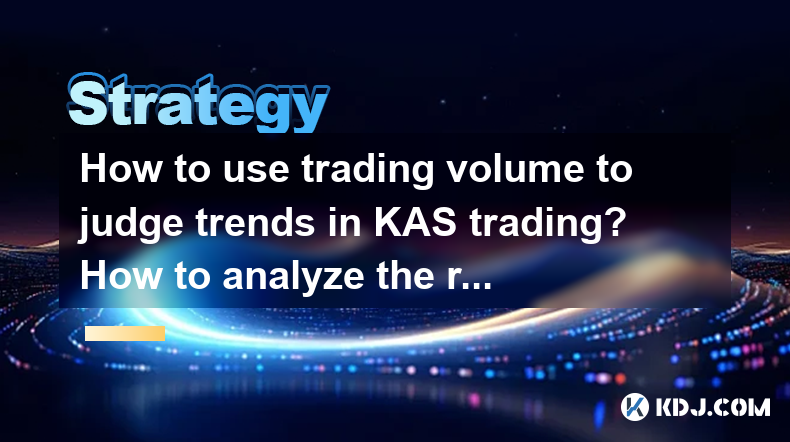-
 bitcoin
bitcoin $121833.232455 USD
-0.63% -
 ethereum
ethereum $4394.437030 USD
-2.00% -
 tether
tether $1.000570 USD
0.04% -
 bnb
bnb $1255.553465 USD
-3.73% -
 xrp
xrp $2.814944 USD
-1.59% -
 solana
solana $221.835346 USD
-2.40% -
 usd-coin
usd-coin $0.999869 USD
0.01% -
 dogecoin
dogecoin $0.249495 USD
-1.32% -
 tron
tron $0.336905 USD
-1.24% -
 cardano
cardano $0.816464 USD
-1.69% -
 chainlink
chainlink $22.130946 USD
-1.27% -
 hyperliquid
hyperliquid $44.208522 USD
-3.46% -
 ethena-usde
ethena-usde $1.000521 USD
0.02% -
 sui
sui $3.422897 USD
-2.51% -
 stellar
stellar $0.380164 USD
-1.31%
How to use trading volume to judge trends in KAS trading? How to analyze the relationship between volume and price?
High trading volume in KAS can confirm trends; rising prices with increasing volume suggest strong buying pressure, while falling prices with high volume indicate strong selling pressure.
May 03, 2025 at 10:21 am

Trading volume is a crucial metric in the world of cryptocurrency trading, and it plays a significant role in understanding market trends and making informed trading decisions. In this article, we will delve into how to use trading volume to judge trends in KAS (Kaspa) trading and analyze the relationship between volume and price. By understanding these concepts, traders can gain insights into market sentiment and make more strategic trading moves.
Understanding Trading Volume in KAS Trading
Trading volume represents the total number of KAS coins that are traded within a specific time frame, typically measured in daily, weekly, or monthly periods. It is an indicator of the level of activity and interest in KAS at any given time. High trading volume often signifies strong interest and liquidity, while low volume may indicate a lack of interest or a more stagnant market.
When analyzing KAS trading, it is important to look at the volume in conjunction with price movements. Volume can confirm trends; if the price of KAS is rising and the volume is increasing, it suggests that the upward trend is supported by strong buying pressure. Conversely, if the price is falling and the volume is high, it indicates strong selling pressure, reinforcing the downward trend.
Using Volume to Identify Trends in KAS
To effectively use trading volume to judge trends in KAS trading, traders should focus on the following aspects:
- Volume spikes: Sudden increases in trading volume can signal significant events or shifts in market sentiment. For instance, if KAS experiences a sharp increase in volume alongside a price surge, it might indicate the beginning of a bullish trend.
- Volume trends: Consistently high or increasing volume over time can confirm the strength of a trend. If KAS is in an uptrend and the volume is steadily increasing, it suggests that the trend is likely to continue.
- Volume divergence: If the price of KAS is moving in one direction but the volume is moving in the opposite direction, it may signal a potential reversal. For example, if the price is increasing but the volume is decreasing, it could indicate that the uptrend is losing momentum.
Analyzing the Relationship Between Volume and Price in KAS
The relationship between volume and price in KAS trading is fundamental to understanding market dynamics. Here's how to analyze this relationship:
- Volume preceding price: Often, changes in volume can precede changes in price. If you notice a significant increase in KAS trading volume before a price movement, it can be an early indicator of a potential trend change.
- Volume confirming price: When the price of KAS moves in a certain direction and the volume supports that move, it confirms the validity of the trend. For instance, if KAS's price breaks above a resistance level with high volume, it confirms the breakout and suggests a strong bullish trend.
- Volume at support and resistance levels: Volume can provide insights into the strength of support and resistance levels. If KAS approaches a support level with high volume, it suggests strong buying interest, potentially leading to a price rebound. Conversely, high volume at resistance levels can indicate strong selling pressure, possibly resulting in a price rejection.
Practical Steps to Use Volume in KAS Trading Analysis
To effectively incorporate volume into your KAS trading strategy, follow these practical steps:
- Monitor volume charts: Use a reliable trading platform that provides detailed volume charts for KAS. Observe the volume bars alongside the price candlesticks to identify patterns and trends.
- Set volume alerts: Many trading platforms allow you to set alerts for significant volume changes. Configure these alerts to notify you of sudden spikes or sustained increases in KAS trading volume.
- Combine volume with other indicators: While volume is a powerful tool, it is most effective when used in conjunction with other technical indicators such as moving averages, RSI, and MACD. This comprehensive approach can provide a more robust analysis of KAS market trends.
- Backtest volume-based strategies: Use historical KAS trading data to backtest strategies that rely on volume analysis. This can help you refine your approach and understand how volume has historically influenced price movements.
Volume and Market Sentiment in KAS Trading
Volume can also provide valuable insights into market sentiment for KAS. High volume during price increases suggests bullish sentiment, as more traders are buying KAS, driving the price up. On the other hand, high volume during price decreases indicates bearish sentiment, with more traders selling KAS, pushing the price down.
To gauge market sentiment using volume, consider the following:
- Volume during news events: If KAS experiences high volume around significant news events or announcements, it can reflect how the market is reacting to the news. Positive news coupled with high volume can lead to a bullish surge, while negative news with high volume can trigger a bearish drop.
- Volume during market volatility: During periods of high volatility, volume can help you understand whether the market is experiencing panic selling or aggressive buying. High volume during sharp price movements can indicate strong market sentiment in either direction.
Volume Analysis Tools for KAS Trading
Several tools and indicators can assist traders in analyzing volume for KAS trading. Here are some of the most commonly used:
- Volume Oscillator: This indicator measures the difference between two moving averages of volume. It helps identify trends in volume and can signal potential shifts in market momentum.
- On-Balance Volume (OBV): OBV adds volume on up days and subtracts volume on down days. It helps traders understand the flow of volume in relation to price movements and can confirm trends in KAS trading.
- Volume Profile: This tool displays volume data at different price levels over a specified period. It can help identify key support and resistance levels based on where the majority of the volume has occurred.
FAQs
Q: Can trading volume alone predict future price movements in KAS?A: While trading volume can provide valuable insights into market trends and sentiment, it should not be used in isolation to predict future price movements. It is most effective when combined with other technical indicators and fundamental analysis.
Q: How can I access reliable volume data for KAS trading?A: Reliable volume data for KAS can be accessed through various cryptocurrency trading platforms such as Binance, Coinbase, or specialized crypto data providers like CoinMarketCap and TradingView.
Q: What is the significance of volume spikes in KAS trading?A: Volume spikes in KAS trading can indicate significant market events or shifts in sentiment. They can signal the beginning of a new trend or a potential reversal, depending on the context of the price movement accompanying the spike.
Q: How often should I monitor the volume for KAS trading?A: The frequency of monitoring volume depends on your trading strategy. For short-term traders, monitoring volume on an hourly or daily basis can be beneficial, while long-term investors might focus on weekly or monthly volume trends.
Disclaimer:info@kdj.com
The information provided is not trading advice. kdj.com does not assume any responsibility for any investments made based on the information provided in this article. Cryptocurrencies are highly volatile and it is highly recommended that you invest with caution after thorough research!
If you believe that the content used on this website infringes your copyright, please contact us immediately (info@kdj.com) and we will delete it promptly.
- Chainlink, Reserve, LINK Price: Decoding the Signals
- 2025-10-10 10:45:14
- Meme Coins, ETFs, and Crypto Regulations: Navigating the Wild West of Digital Finance
- 2025-10-10 10:25:15
- HYPE, PENGU, and BlockDAG: Decoding Crypto's Latest Moves
- 2025-10-10 10:25:15
- Robinhood, Zora, and the Web3 Creator Revolution: A New York Minute on Tokenized Futures
- 2025-10-10 10:30:01
- Trump, Super Bowl, and Halftime: A Wild 2025 Ride
- 2025-10-10 10:30:01
- Cardano, XRP, and DeFi Integration: A Bombshell Development?
- 2025-10-10 08:25:17
Related knowledge

Practical parameter settings for a Bitcoin multi-timeframe moving average system
Sep 18,2025 at 10:54pm
Optimizing Timeframe Combinations for Bitcoin Trading1. Selecting appropriate timeframes is crucial when building a multi-timeframe moving average sys...

How can I filter out false breakouts in Dogecoin high-frequency trading?
Sep 22,2025 at 01:00am
Understanding False Breakouts in Dogecoin Trading1. A false breakout occurs when Dogecoin's price appears to move beyond a defined support or resistan...

Techniques for identifying tops and bottoms in the Bitcoin on-chain NVT model
Sep 20,2025 at 07:54pm
Understanding the NVT Model in Bitcoin Analysis1. The Network Value to Transactions (NVT) ratio is often described as the 'P/E ratio' of the cryptocur...

What does the surge in open interest in Bitcoincoin futures mean?
Sep 20,2025 at 11:18pm
Understanding the Surge in Dogecoin Futures Open Interest1. A surge in open interest within Dogecoin futures indicates a growing number of active cont...

How can I use the Ethereum USDT premium to gauge market sentiment?
Sep 18,2025 at 11:55pm
Understanding the Ethereum USDT Premium1. The Ethereum USDT premium refers to the price difference between USDT (Tether) traded on Ethereum-based plat...

What should I do if Ethereum staking yields decline?
Sep 20,2025 at 06:18am
Understanding the Causes Behind Declining Ethereum Staking Yields1. The Ethereum network transitioned to a proof-of-stake consensus mechanism with the...

Practical parameter settings for a Bitcoin multi-timeframe moving average system
Sep 18,2025 at 10:54pm
Optimizing Timeframe Combinations for Bitcoin Trading1. Selecting appropriate timeframes is crucial when building a multi-timeframe moving average sys...

How can I filter out false breakouts in Dogecoin high-frequency trading?
Sep 22,2025 at 01:00am
Understanding False Breakouts in Dogecoin Trading1. A false breakout occurs when Dogecoin's price appears to move beyond a defined support or resistan...

Techniques for identifying tops and bottoms in the Bitcoin on-chain NVT model
Sep 20,2025 at 07:54pm
Understanding the NVT Model in Bitcoin Analysis1. The Network Value to Transactions (NVT) ratio is often described as the 'P/E ratio' of the cryptocur...

What does the surge in open interest in Bitcoincoin futures mean?
Sep 20,2025 at 11:18pm
Understanding the Surge in Dogecoin Futures Open Interest1. A surge in open interest within Dogecoin futures indicates a growing number of active cont...

How can I use the Ethereum USDT premium to gauge market sentiment?
Sep 18,2025 at 11:55pm
Understanding the Ethereum USDT Premium1. The Ethereum USDT premium refers to the price difference between USDT (Tether) traded on Ethereum-based plat...

What should I do if Ethereum staking yields decline?
Sep 20,2025 at 06:18am
Understanding the Causes Behind Declining Ethereum Staking Yields1. The Ethereum network transitioned to a proof-of-stake consensus mechanism with the...
See all articles

























![Web3 Crypto Market Morning Report: Fomo on the Bnb chain continues, Binance launches the chain-sweeping platform Meme Rush, the market value of Xiuxian exceeds 40 million U.S. dollars, OK Binance business war begins [Vic TALK Issue 1437] Web3 Crypto Market Morning Report: Fomo on the Bnb chain continues, Binance launches the chain-sweeping platform Meme Rush, the market value of Xiuxian exceeds 40 million U.S. dollars, OK Binance business war begins [Vic TALK Issue 1437]](/uploads/2025/10/10/cryptocurrencies-news/videos/web-crypto-market-morning-report-fomo-bnb-chain-continues-binance-launches-chainsweeping-platform-meme-rush-market-xiuxian-exceeds-dollars-binance-business-war-vic-talk-issue/68e861c5dbd1c_image_500_375.webp)
















































